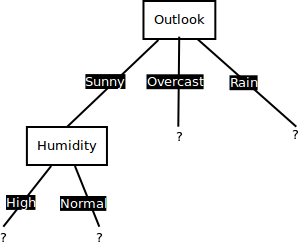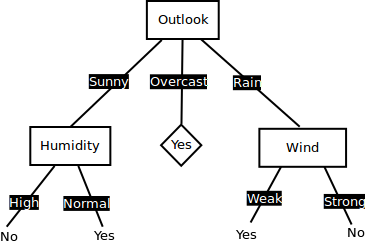In this lab, we will simulate the example from the previous lesson in python. We will write functions to calculate entropy and IG which will be used for calculating these uncertainty measures and deciding upon creating a split using information gain while growing a ID3 classification tree. We shall attempt to write general function that can be used for other (larger) problems as well. So let's get on with it.
You will be able to:
- Write functions for calculating Entropy and Information gain measures
- Identify the attribute for best split at master and each subsequent node
We shall use the same problem about deciding weather to go and play tennis on a given day, given the weather conditions. Here is the data from previous lesson:
Write a function entropy(pi) to calculate total entropy in a given discrete probability distribution pi
- The function should input a probability distribution
pias an array of class distributions - Calculate and return entropy according to the formula:
$$Entropy(p) = -\sum (P_i . log_2(P_i))$$
from math import log
def entropy(pi):
'''
return the Entropy of a probability distribution:
entropy(p) = - SUM (Pi * log(Pi) )
'''
pass
# Test the function
print(entropy([1,1])) # Maximum Entropy e.g. a coin toss
print (entropy([0,6])) # No entropy, ignore the -ve with zero , its there due to log function
print (entropy([2,10])) # A random mix of classes
# 1.0
# 0.0
# 0.6500224216483541None
None
None
- The function should input
Das a class distribution array for target class, andathe class distribution of the attribute to be tested - Using the
entropy()function above, calculate the information gain as:
where Di represents distribution of each class in a.
def IG(D, a):
'''
return the information gain:
gain(D, A) = entropy(D)− SUM( |Di| / |D| * entropy(Di) )
'''
pass
# Uncomment to run the test
# set of example of the dataset - distribution of classes
test_dist = [6, 6] # Yes, No
# attribute, number of members (feature)
test_attr = [ [4,0], [2,4], [0,2] ] # class1, class2, class3 of attr1 according to YES/NO classes in test_dist
print(IG(test_dist, test_attr))
# 0.5408520829727552None
- Create The class distribution
playas a list showing frequencies of both classes from the dataset - Similarly create variables for four categorical feature attributes showing the class distribution for each class with respect to the target classes (yes and no)
- Pass the play distribution with each attribute to calculate the information gain
# Your code here
# Information Gain:
# Outlook: 0.2467498197744391
# Temperature: 0.029222565658954647
# Humidity: 0.15183550136234136
# Wind:, 0.04812703040826927Information Gain:
Outlook: 0.2467498197744391
Temperature: 0.029222565658954647
Humidity: 0.15183550136234136
Wind:, 0.04812703040826927
We see here that the outlook attribute gives us the highest value for information gain, hence we choose this for creating a split at root node. So far we have our root node looking as below:

For the branch (edge) of three above that leads to the "Sunny" outcome. Check for temperature, humidity and wind attributes to see which one provides the highest information gain.
For the steps as above. Remember we only have 2 positive and 3 negative examples in the "sunny" branch.
# Your code here
# Information Gain:
# Temperature: 0.7974288158134881
# Humidity: 0.9402859586706309
# Wind:, 0.5117145300992023Information Gain:
Temperature: 0.7974288158134881
Humidity: 0.9402859586706309
Wind:, 0.5117145300992023
So here we see that humidity gives us the the highest information gain, so we shall use this to split our tree as shown below:

Let's now see how to get to the leaf nodes using the branches from the node which we split on humidity above.
We now have humidity which has two possible values [High, Normal]. A branch High dominated by single label which is No, caused this branch ended with a leaf contains label No. Same case with branch Normal which ended with a leaf contains label Yes. so we dont split these leaves any further as they are now "pure leaves" and will get shown as below:
All rows contains value "Overcast" contain single label Yes in the target, so branch of Overcast ends with a leaf contains label Yes. Just like above, it is a pure leaf and wont get split any further.
We will now check which is the best attribute for branch of "Rain". Remember, that new distribution is only rows containing values of Rain i.e. 3 positive and 2 negative examples. Repeat the process we did for master node and second iteration to see which attribute gives the best information gain.
# Your code here
# Information Gain:
# Temperature: 0.01997309402197489
# Humidity: 0.01997309402197489
# Wind:, 0.9709505944546686Information Gain:
Temperature: 0.01997309402197489
Humidity: 0.01997309402197489
Wind:, 0.9709505944546686
Right, its wind this time, giving us the highest information gain. So that is what we use for the split. This will result as following:
Next node is an attribute "Wind" with two possible classes [Weak, Strong]. A branch Strong dominated by single label which is No, caused this branch ended with a leaf contains label No. Same case with branch Weak which ended with a leaf contains label Yes. so no further splitting is required and we can declare these as leaf nodes as shown below.

So now we have all branches ending on leaf nodes, and these nodes are "pure" containing only positive or negative examples. So no further splitting is required and we now have a decision tree ready for classification. Also, notice that we did not use the the "Temperature" for splitting at any stage. We have effectively "pruned" that feature to leave it out of the training process as it we have better predictors helping us fully tidy up the data. We shall look more into pruning in following lessons.
Decision tree is a very simple model that you can build from starch easily. One of popular Decision Tree algorithm is ID3. Basically, we only need to construct tree data structure and implements two mathematical formula to build complete ID3 algorithm as we saw above. We shall look into this implementation with sklearn in our next lesson.



